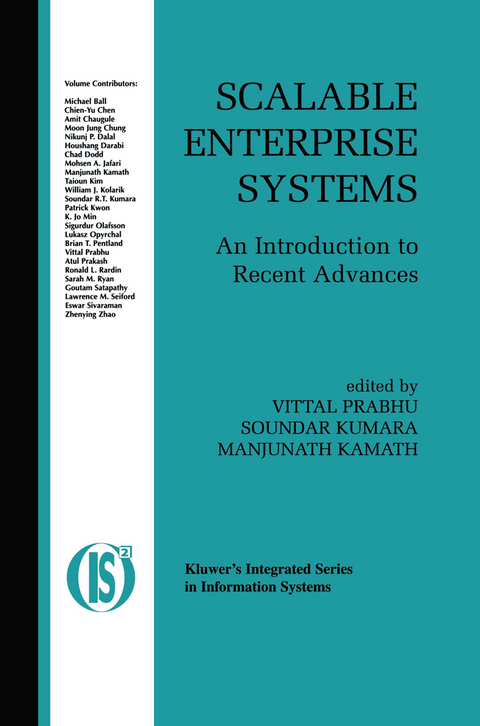
Scalable Enterprise Systems
Springer-Verlag New York Inc.
978-1-4020-7491-2 (ISBN)
The National Science Foundation (NSF) is the leading sponsor of basic academic research in engineering, and its influence far exceeds its budget. We think NSF is at its best when it uses that influence to focus interest within the researcher community on critical new challenges and technologies. NSF's Scalable Enterprise Systems (SES) initiative, for which we were responsible in our successive terms in the division of Design, Manufacture and Industrial Innovation (DMII), was just such a venture. A collaborative effort spanning NSF's engineering and computer science directorates, SES sought to concentrate the energies of the academic engineering research community on developing a science base for designing, planning and controlling the extended, spatially and managerially distributed enterprises that have become the norm in the manufacture, distribution and sale of the products of U. S. industry. The of associated issues addressed included everything from management supply chains, to product design across teams of collaborating companies, to e-marketing and make-to-order manufacturing, to the information technology challenges of devising inter-operable planning and control tools that can scale with exploding enterprise size and scope. A total of 27 teams with nearly 100 investigators were selected from the 89 submitted proposals in the Phase I, exploratory part of the effort (see the list below). Seven of these were awarded larger multi-year grants to continue their research in Phase II. As the contents of this book amply illustrate, these investigations continue to flourish, with and without direct NSF support.
1. A Review of Enterprise Process Modelling Techniques.- 1. Introduction.- 2. Review of Process Modelling Techniques.- 3. Modelling Next-Generation Enterprises.- 4. The Distributed Integrated modelling of enterprises (DME) framework.- 5. Conclusions.- 6. Acknowledgements.- 7. References.- 2. Design and Manufacturing Process Management in a Network of Distributed Suppliers.- 1. Introduction.- 2. Background.- 3. Process modeling: A brief review.- 4. Functional Requirements of Process Management: Specification and Execution.- 5. Description of Midas System.- 6. Process Flow Generation and Execution.- 7. Percolation and Sensitivity Analysis: Process Expansion.- 8. A simple example.- 9. Conclusion.- 3. Finite Automata Modeling and Analysis of Supply Chain Networks.- 1. Introduction.- 2. Preliminaries.- 3. Supply Chain Modeling.- 4. Supply Chain Analysis.- 5. “GOURMET-TO-GO”- A Case Study.- 6. Conclusion.- 4. Distributed Control Algorithms for Scalable Decision-Making from Sensors-to Suppliers.- 1. Introduction.- 2. Feedback Control of Discrete Event-Timing.- 3. Modeling Event Timing Control Using Discontinuous Differential Equations.- 4. Unified Modeling and Control from Sensors-to-Suppliers.- 5. Conclusions.- 6. References.- 5. Collaborative Multiagent Based Information Infrastructure for Transportation Problem Solving.- 1. Introduction.- 2. The Transportation problem.- 3. AGENT Interactions.- 4. Multiagent Model.- 5. Comparison with Other Research.- 6. Conclusions.- 6. Improving Scalability of E-Commerce Systems with Knowledge Discovery.- 1. Background.- 2. Case Study: Online Auctions for Recyclable Products.- 3. The Curse of Dimensionality.- 4. Expediting the System Operations.- 5. Improving Scalability of an Online Auction System.- 6. Conclusions.- References.- 7. AScalable Supply Chain Infrastructure Research Test-Bed.- 1. Background.- 2. A Scalable SCI test-bed Architecture.- 3. Advanced decision models.- 4. Support for Other Research Projects.- 5. Conclusions.- 6. Acknowledgements.- 7. References.- 8. Publish Subscribe Middleware.- 1. Introduction.- 2. Evolution of Publish Subscribe Systems.- 3. Design Issues in Content Based Systems.- 4. Event Multicast in Content Based Systems.- 5. Secure end point delivery.- 6. Summary.- 9. Experimental Study of Scalability Enhancement for Reverse Logistics E-Commerce.- 1. Introduction.- 2. Description of Experimental Prototype.- 3. Experimental Design.- 4. Auction Recommender.- 5. Conclusion.- 10. Web-Based Distributed Multi-Agent Architecture for Implementing Value Nets.- 1. Introduction.- 2. Literature Review.- 3. Multi-Agent Architecture.- 4. Agent Communication.- 5. Implementation of Multi-agents for value nets.- 6. Conclusions.- 7. Future work.
| Erscheint lt. Verlag | 30.9.2003 |
|---|---|
| Reihe/Serie | Integrated Series in Information Systems ; 3 |
| Zusatzinfo | XXXI, 338 p. |
| Verlagsort | New York, NY |
| Sprache | englisch |
| Maße | 155 x 235 mm |
| Themenwelt | Mathematik / Informatik ► Mathematik ► Finanz- / Wirtschaftsmathematik |
| Wirtschaft ► Allgemeines / Lexika | |
| ISBN-10 | 1-4020-7491-3 / 1402074913 |
| ISBN-13 | 978-1-4020-7491-2 / 9781402074912 |
| Zustand | Neuware |
| Haben Sie eine Frage zum Produkt? |
aus dem Bereich


